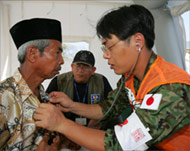Japan’s tsunami defences scrutinised
Shocked at the scale of the Indian Ocean tsunami and the devastation that it left in its wake, experts charged with protecting Japan’s citizens from a similar disaster are re-examining the country’s defences.

As one of the world’s most earthquake-prone nations and, even in recent years, the victim of what are termed “giant tsunamis”, Japan has since 1952 been developing its Pacific Tsunami Warning System.
And while it is regarded as the best in the world, recent events suggest that it still might not be enough.
“The scale of the Indian Ocean tsunami came as a surprise because events like that, a magnitude 9 quake, only happen once every 100 years,” Masahiro Yamamoto, director of the Earthquake and Tsunami Observation Division at the Japan Meterological Agency, said.
“It was too big for us to even calculate its magnitude at first, and that’s very unusual,” he added. “It is never easy to predict the size or speed of a tsunami, but we do our best. Now we want to learn from this incident.”
Tsunami walls
The agency operates six regional centres around Japan that monitor a network of 300 seismic sensors, including 80 on the seabed. The gauges record seismic activity and water pressure around the clock and – if a quake indicates it is likely to trigger a tsunami based on its location, strength and depth below the surface – they enable the JMA to issue an alert.
 |
|
Disaster-prone Japan was quick |
Local authorities in coastal regions have also invested in offshore tsunami walls, quake-resistant shelters and floodgates at the mouths of some rivers.
The agency aims to have its alert on radio channels and TV screens within three minutes, according to Yamamoto, although in reality it is often closer to five minutes.
All Japanese are familiar with the outline of the Japanese archipelago on their TV screen, with thick red lines marked along areas most at risk of a tsunami after a major quake, and although the JMA aims to give a 10-minute warning to allow residents to evacuate, that is not always enough.
Early on 12 July 1993, a magnitude 7.8 quake off Okushiri Island, off the west coast of Hokkaido, generated a 30-metre high tsunami that killed 239 islanders, the worst tsunami death toll in half a century.
Knowledge gap
“Our warning system is quite well prepared, but still there is the concern that we may have overlooked something,” Masataka Ando, a professor at Nagoya University’s Research Centre for Seismology, Volcanology and Disaster Mitigation, said.
 |
|
Asia is looking to Japan for help |
“We still do not understand nature well enough to say that we can absolutely predict tsunami and we need to continue to modernise our warning system and continually check all the data.”
And while the 10-minute warning is the hoped-for response time, a quake closer to the shore could cut that time dramatically. In a worst-case scenario, according to projections in 2003 by Japan’s Central Disaster Management Council, three simultaneous quakes could generate a magnitude of 8.7, killing 28,000 people, including nearly 13,000 in tsunami.
An equally large concern, according to professor Nobuo Shuto, is that a relatively small earthquake might not be recognised as posing a major tsunami threat.
Weak point
“The forecasting system is based on 100,000 computer-generated models of a tsunami and is, generally, excellent,” Shuto, a professor of tsunami engineering at Iwate Prefectural University, said.
 |
|
The Asian tsunami’s scale took |
“But it has a serious weak point,” he added. “It works on the principle that a small quake will not cause a big tsunami.
“We know that one out of every 10 undersea quakes are what we call’tsunami earthquakes’ because they may be small, but they still generate very powerful tsunami.”
In 1896, a small quake off northern Japan was considered insignificant. Within minutes, it had built into a 40-metre “giant tsunami” that claimed 22,000 lives.
In 1933, a similar tremor caused a 28-metre wave that killed 3000 people in Iwate Prefecture.
“In both cases, no one expected a large tsunami and no one tried to evacuate the coastal regions,” he said. “We must learn how to predict these tsunami, but I think it will take another 100 years, at least.”